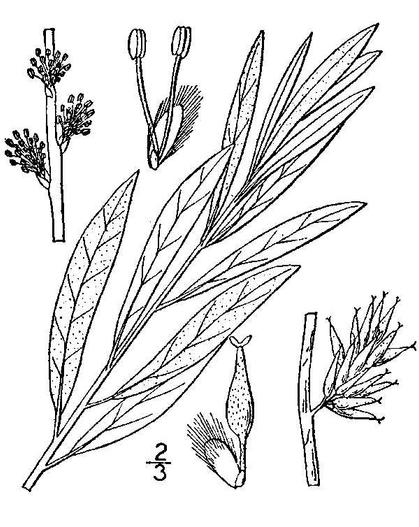Prairie Willow
(Salix humilis var. tristis)
Prairie Willow (Salix humilis var. tristis)
/
/

Britton, N.L., and A. Brown
Public domain
Image By:
Britton, N.L., and A. Brown
Recorded By:
Copyright:
Public domain
Copyright Notice:
Photo by: Britton, N.L., and A. Brown | License Type: Public domain | License URL: https://creativecommons.org/public-domain/ | Uploader: JoJan | Publisher: Wikipedia Commons



























Estimated Native Range
Summary
Salix humilis var. tristis, commonly known as Prairie Willow, is a deciduous shrub native to North America, specifically found in prairies, open fields, and along stream banks in the central and Eastern United States. It typically grows to a modest height of 3-6 feet (0.9-1.8 meters) with a similar spread, and is characterized by its slender branches and narrow, lance-shaped leaves. The Prairie Willow blooms in early spring, producing small, yellowish catkins that are not particularly showy but are valuable for early-season pollinators.
Prairie Willow is appreciated for its hardiness and adaptability, often used in restoration projects and naturalized plantings. It is tolerant of poor soils, including those that are sandy or rocky, and can withstand drought conditions once established. This makes it suitable for erosion control and as a windbreak in challenging environments. In cultivation, it prefers full sun to partial shade and can handle a variety of soil types, though it thrives in moist, well-drained soils. While not commonly used in ornamental horticulture, it can be a practical choice for wildlife gardens, as it provides cover and food for birds and other animals.CC BY-SA 4.0
Prairie Willow is appreciated for its hardiness and adaptability, often used in restoration projects and naturalized plantings. It is tolerant of poor soils, including those that are sandy or rocky, and can withstand drought conditions once established. This makes it suitable for erosion control and as a windbreak in challenging environments. In cultivation, it prefers full sun to partial shade and can handle a variety of soil types, though it thrives in moist, well-drained soils. While not commonly used in ornamental horticulture, it can be a practical choice for wildlife gardens, as it provides cover and food for birds and other animals.CC BY-SA 4.0
Plant Description
- Plant Type: Shrub
- Height: 3-8 feet
- Width: 3-6 feet
- Growth Rate: Moderate
- Flower Color: N/A
- Flowering Season: Spring
- Leaf Retention: Deciduous
Growth Requirements
- Sun: Full Sun, Part Shade
- Water: Medium
- Drainage: Medium, Fast
Common Uses
Bird Garden, Butterfly Garden, Erosion Control, Low Maintenance
Natural Habitat
native to North America, specifically found in prairies, open fields, and along stream banks in the central and Eastern United States
Other Names
Common Names: Prairie Willow, Upland Willow
Scientific Names: , Salix humilis var. tristis, Oisodix oblongifolia, Salix alpina, Salix humilis var. microphylla, Salix longirostris, Salix muehlenbergiana, Salix occidentalis, Salix recurvata, Salix tristis
GBIF Accepted Name: